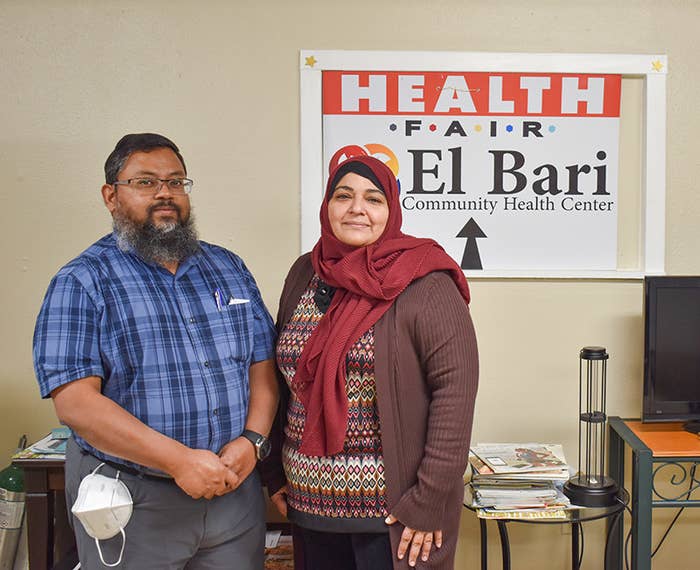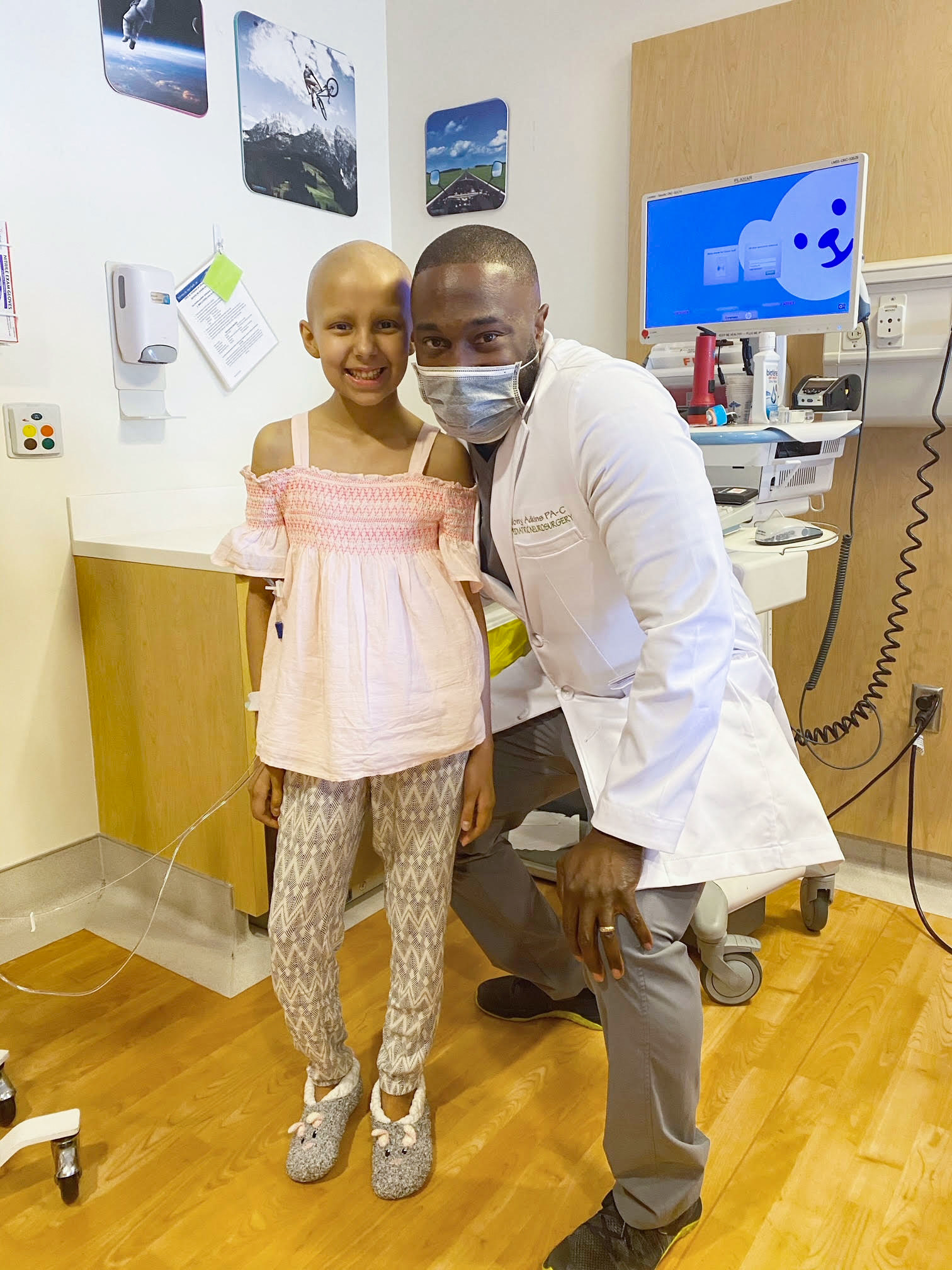
On a warm Thursday evening, Dr. Sarah Samreen adjusted her maroon hijab and raised her hands to begin Isha, the fifth prayer of the day, at the Muslim Children Education and Civic Center in San Antonio. When she finished her worship, the clock read 8:15 p.m.
Samreen, a doctor at the local Veterans Affairs hospital, had been up since 6 a.m., but wasn’t done for the day. She reunited with her husband, Dr. Suhaib Haq, and walked to the El Bari Community Health Center a few feet away. The couple founded the free clinic in 2014 to serve Bexar County’s uninsured population, which was at 19.1% in 2021.
Every year, the clinic’s staff sees over 700 patients from different racial and religious backgrounds.
"You save one life, you save the whole of humanity," Haq said, quoting the Qur'an. The verse features prominently in a picture in the waiting room, a reminder of the higher purpose that Samreen and Haq serve as physicians.

And it's this dedication that keeps them going, despite the stressors of their jobs. “Working at El Bari is anti-burnout,” Haq said. “It just refuels you.”
Healthcare workers across the US are burned out. More than half of nurses and physicians, 60% of medical students and residents, and 61% to 75% of pharmacists reported having symptoms of burnout in the National Academy of Medicine’s National Plan for Health Workforce Well-Being, which was released in October.
“This has been a trend that started before COVID but gotten much worse after COVID,” said Dr. Victor Dzau, president of the organization. Factors such as the work culture, mental health stigma, administrative workload, demanding hours, and even the lack of diversity in the workforce all contribute toward burnout, he said. This is causing many healthcare workers to leave the profession. Data from the US Bureau of Labor Statistics show that over 2% of the healthcare workforce quit every month.
“If you want to get the best patient care, support our patients, we know the doctors and nurses and everybody else should be well taken care of,” Dzau said.
While Haq and Samreen rely on their Islamic faith for their mental health and to fight burnout, not all spirituality-related practices are based in religion. Dr. Uday Nanavaty, pulmonary critical care and sleep medicine specialist based in Maryland, uses yoga and meditation.
“Most of the Western exercises that we do, whether it is running or swimming or hiking, they are all contraction-based,” he said, alluding to how muscles tighten and lengthen during cardio workouts. “Whereas yoga is active relaxation, when you assume a particular posture in yoga called the asana, the entire muscle gets relaxed.”
Healthcare workers should take care of themselves, Nanavaty said, because if the healer is sick, they cannot effectively treat a patient.
Before the COVID-19 pandemic, his focus was shifting from critical care to pulmonary and sleep medicine. However, the pandemic upended those plans. Overnight, he became an internist and saw firsthand some of the horrors of the disease; young patients were having heart attacks and rapid respiratory failures.
“Between January of 2020 and August of 2021, in that span of a year and a half of pandemic, in my area, eight pulmonologists left [their] practice,” he said. Some retired early because they did not want to contract COVID, and this put a greater burden on other physicians and respiratory therapists.
Yoga and meditation helped calm Nanavaty during these months of mass death and uncertainty. His day begins with a 10-to15-minute meditation, seated on the ground in a minimally decorated area. He starts by repeating a single word before shifting his focus to just one thought, letting his mind relax. Nanavaty ends with a Sanskrit chant, “Let all be happy, let all be healthy, let all be prosperous and may not suffer.”
Starting his day in this manner, he said, helps “park my mind into a peaceful state.”
While yoga and meditation have helped Nanavaty combat the stressors of working in healthcare, Maurice “Tony” Adkins, a physician assistant in pediatric neurosurgery at Children's Health of Orange County in California, finds joy and relaxation in music and dance. Adkins said working in his field is like working as a “homicide detective” because you see kids with a slew of neurological injuries, traumas, and congenital disabilities.

“[Dancing] is a form of pulling myself back to where I need to be," he said.
And Adkins isn’t the only one who benefits. “I use music and dance to relieve me and help the children and the parents,” he said. “They see their children laughing, having a good time, and making memories.”
As a kid growing up in South Central Los Angeles, Adkins said he would use music to drown out the police sirens, gun violence, and helicopters that flew over his neighborhood. MTV and VH1 became his solace. When a music video played, he said, he felt as though he was being pulled out of his environment.
One day, when he was doing rounds in 2018, he saw one of his patients looking sad. The boy was in remission from leukemia but still had headaches and other neurological issues. Thinking about his own childhood, Adkins played “U Can’t Touch This” by MC Hammer and started dancing in the hospital room.
The boy “had the time of his life,” Adkins recalled. The patient’s mother filmed them dancing together and put it up on social media, garnering over 14,000 views.
The father of two now listens to music on his 20-minute drive home to decompress. He also says a prayer when leaving the hospital and when he reaches home before unwinding with his family.
“We have to take care of ourselves or we will not survive being in healthcare in this day and age with all the different things that are constantly bombarding us, from social media to mass shootings to people who don't like somebody else because of their religion, ethnicity, or race,” he said.
Chelsea Nicole Walker learned early on that she had to look after herself before entering medical school. The 29-year-old student, pursuing a specialization in podiatry and a graduate certificate in hematology.
Although she is not yet a doctor, even the process of becoming one has been stressful.
“I feel the impostor syndrome every single day. I don't see faces that look like me. And I had a really difficult time getting my foot in the door,” said Walker, who is of Black, Choctaw, and Báxoje ancestry. “Because I came from a community where a lot of people don't go to school, don't go to college. It's very rare for people to get a master's and even rarer to pursue a doctorate.”
"If you keep emptying your cup and don't fill it up, you're not good to anybody.”
In addition to having no guidance in the medical school application process, Walker also sat through uncomfortable instances where her classmates made derogatory comments about people from marginalized communities and lower socioeconomic backgrounds.
These experiences have sometimes resulted in anxiety and depression, she said. And to cope, in addition to prayer, she has found comfort in the Native American belief that “being a healer is something that's the highest honor because you are taking your time and you're helping others in the community.“
She holds the tradition close because Walker’s goal is “to be able to lead other Native American students and other Black students who want to pursue healthcare. … You don't always see people in your community pursuing higher education, so if you can see someone that looks like you, I think it makes you feel I can do this.”
Walker draws from her own experience in wanting to be a community resource; she has also been able to rely on close and extended family and friends to motivate her. They sent her cards, letters, and notes of encouragement to keep trailblazing.
“I feel like I am accomplishing a lot of dreams for other people for my ancestors. I feel like I have this whole ancestral lineage cheering me on every step of the way,” she said, acknowledging how Black and Native people haven’t had equal opportunity.
Maggie Keogh is the director of the Take10 Program at Mount Sinai Health System, which offers support to staffers. She relied on yogic and Buddhist principles to curate “a staff engagement program where we go out actively to each unit to each department and offer a really safe space.”
Keogh pushes a cart around the hospital inviting healthcare workers to take a breather. She plays relaxing music and quickly converts doctors' lounges and patient waiting areas into dimly lit spaces. She offers them an herbal tea and uses essential oils to scent the space.
The response has been significant. This year alone, 15,815 staffers have taken advantage of the program and in the early months of the pandemic in 2020, 27,286 workers sought Keogh’s services.
“It's good to have these breaks,” Keogh said. “It's good to have a positive affirmation time or whatever we need to do to recharge because if you keep emptying your cup and don't fill it up, you're not good to anybody.”
In addition to healthcare workers seeking out spiritual practices to fight burnout, Dzau calls on people in positions of power, including public health officials, hospital CEOS, and educators, to create positive work and learning environments and destigmatize mental health conversations.
He also urged organizations to “institutionalize well-being as a long-term value. You have to believe that it's something you have to do, something that is central to the core value and DNA of healthcare.”
To healthcare workers, he advised finding a work-life balance, identifying support resources, asking for help, and advocating for their colleagues.
“They need to speak up and participate, if not lead the changes as needed, in the areas they work in,” he said. “When you see something that's leading to burnout, you got to speak up and participate being a part of a solution. That's really important.” ●
